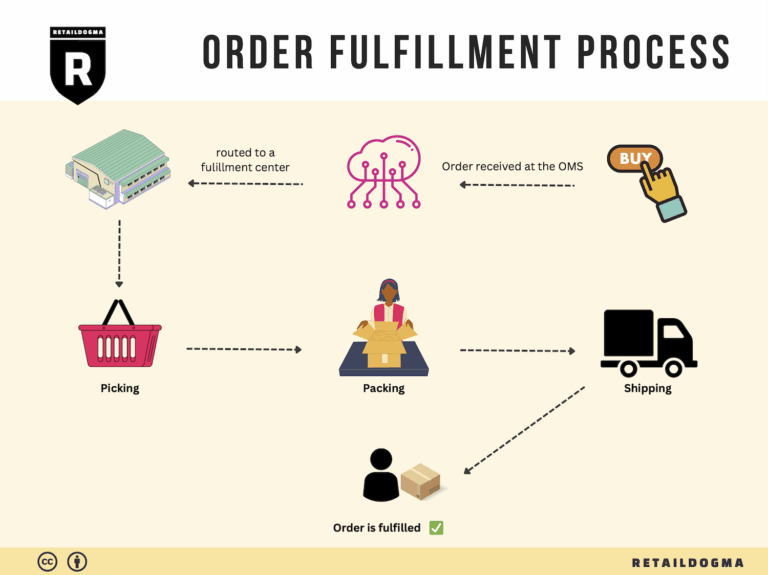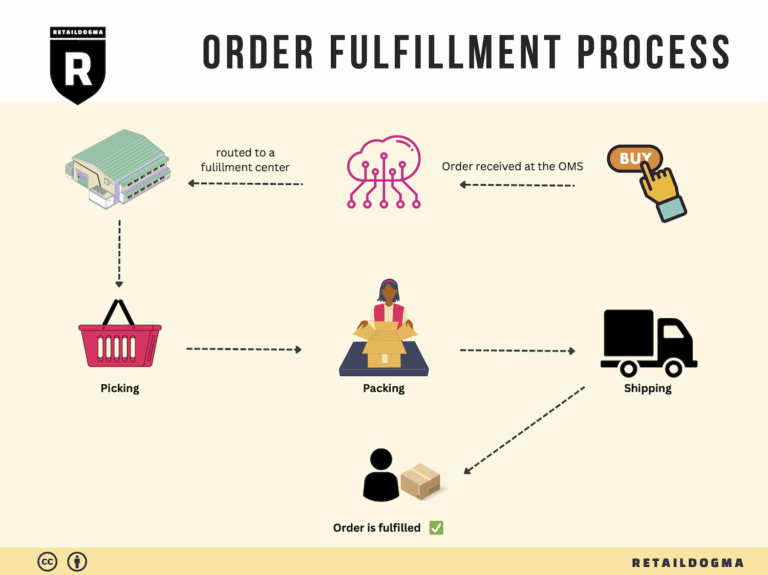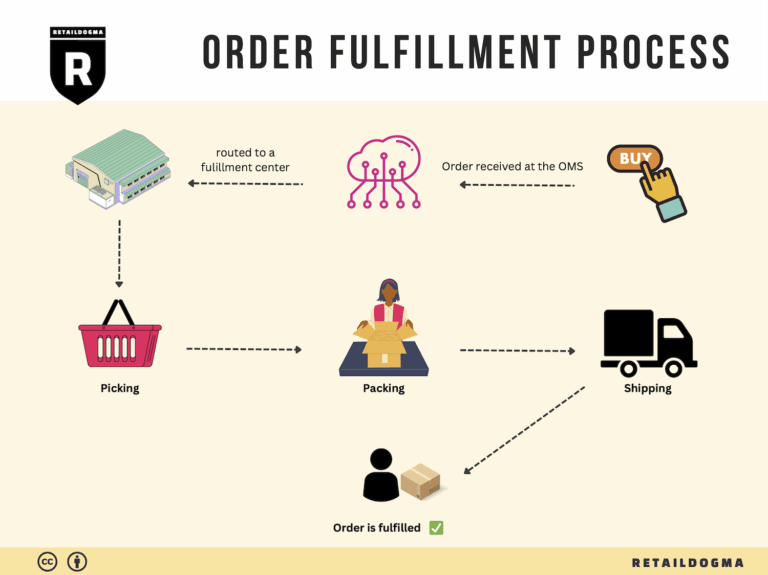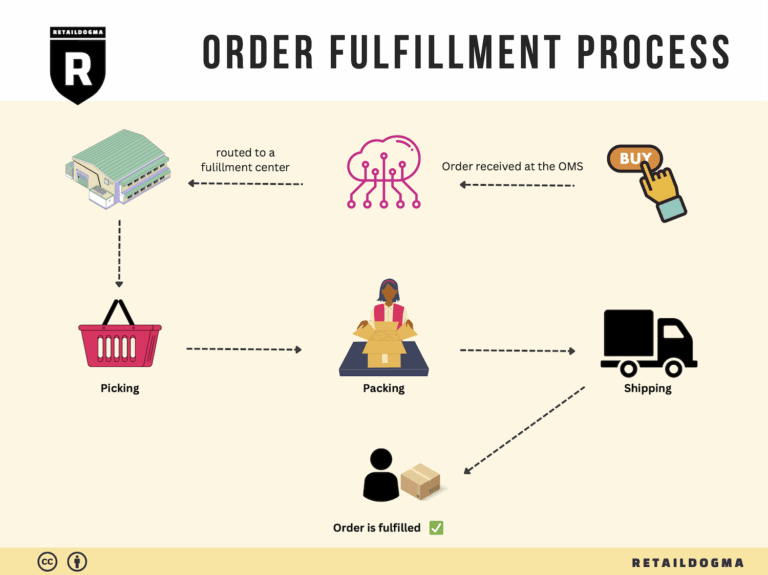Ecommerce Fulfillment Services: The Ultimate Guide (2025)
What is E-commerce Fulfillment? An Introduction for Growing Businesses
As e-commerce businesses grow, many entrepreneurs find themselves overwhelmed by the complexities of packing and shipping orders. The excitement of increasing sales can quickly turn into stress as you juggle inventory management, order processing, and customer service. This is where e-commerce fulfillment comes into play.
Understanding E-commerce Fulfillment
At its core, fulfillment is the process of getting a product from your warehouse to your customer’s doorstep. This includes a range of activities such as storage, inventory management, order processing, picking and packing items, shipping, and handling returns. While it may seem straightforward, the logistics involved can become intricate and time-consuming, especially as order volumes rise.
What This Guide Will Cover
In this guide, we will explore various fulfillment models available to growing businesses. You may have heard of Third-Party Logistics (3PL) and Fulfillment by Amazon (FBA); we’ll break down the differences, benefits, and potential drawbacks of each. Understanding these options is crucial for selecting the right strategy that aligns with your business goals.
We’ll also delve into the core services that a fulfillment partner typically offers. These include warehousing solutions, inventory control, pick and pack services, kitting, shipping logistics, and tracking. Each of these elements plays a significant role in creating a seamless customer experience and ensuring your operations run smoothly.
Choosing the right fulfillment partner can be a daunting task. In this guide, we’ll provide practical tips on what to look for in a logistics partner, including the importance of technology integration, communication, and scalability. You’ll learn how to assess potential partners based on their service offerings, pricing structures, and reputation in the industry.
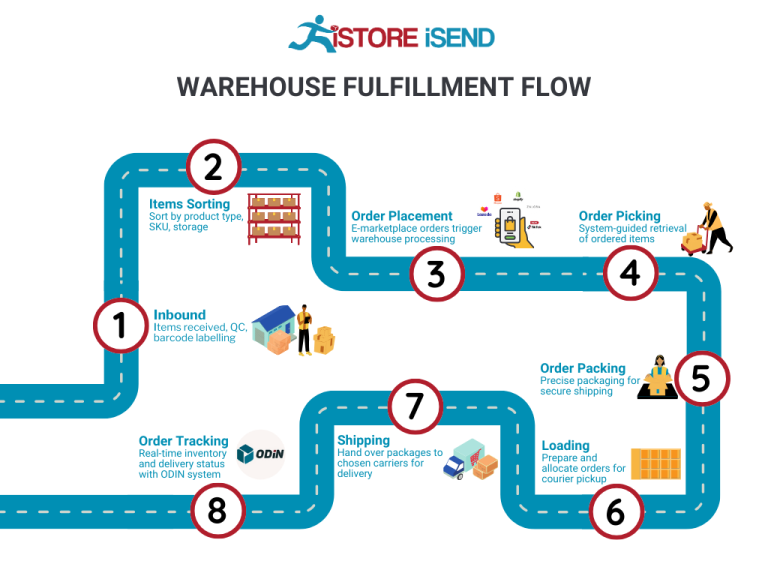
Finally, we will address pricing considerations, helping you understand how to evaluate costs associated with different fulfillment models and services. Transparent pricing is essential for budgeting and ensuring that your logistics expenses remain manageable as you scale.
Empowering Your Business
The ultimate goal of this guide is to empower you with the knowledge and tools necessary to make informed decisions about your e-commerce logistics. By understanding the fulfillment landscape, you can focus on what you do best—growing your business—while leaving the complexities of order fulfillment to the experts. Whether you’re just starting out or looking to optimize your existing processes, this comprehensive resource will help you navigate the world of e-commerce fulfillment with confidence.
What You’ll Learn In This Guide
- What is E-commerce Fulfillment? An Introduction for Growing Businesses
- The Order Fulfillment Process: From ‘Buy’ Button to Customer’s Door
- Comparing Fulfillment Models: In-House vs. 3PL vs. Dropshipping
- A Deep Dive into Amazon FBA: Pros, Cons, and Who It’s For
- Core Services Offered by Fulfillment Centers
- How to Choose a Fulfillment Partner: A 6-Point Checklist
- Understanding Fulfillment Pricing: A Breakdown of Common Fees
- Frequently Asked Questions (FAQs) about Fulfillment
- Conclusion: Is Outsourcing Fulfillment the Right Move for Your Business?
- Important Disclaimer
The Order Fulfillment Process: From ‘Buy’ Button to Customer’s Door
1. Receiving Inventory
The first step in the order fulfillment process begins with receiving inventory. When products arrive at the fulfillment center, they are carefully unloaded and checked against purchase orders. This stage is crucial because it ensures that the right quantities and types of products have been delivered.
During this process, each item is assigned a Stock Keeping Unit (SKU), a unique identifier that helps in tracking inventory throughout the fulfillment process. Proper receiving practices not only prevent discrepancies but also set the foundation for efficient inventory management. Accurate receiving reduces the chances of stockouts or overstock situations, which can impact sales and customer satisfaction.
2. Warehouse Storage
Once inventory is received, the next step is warehouse storage. Products are organized and stored in designated locations within the fulfillment center. The layout is typically optimized for efficiency, enabling quick access to items as orders come in.
This step is important because effective warehouse storage maximizes space utilization and minimizes retrieval time. Utilizing bin locations and pallet racking systems allows for systematic organization and easy inventory management. Furthermore, advanced warehouse management systems (WMS) track inventory levels in real time, providing insights into stock availability and helping businesses maintain optimal inventory levels.
3. Order Picking
With inventory securely stored, the next phase is order picking, where items are gathered based on customer orders. This process typically relies on pick lists, which detail the specific items and quantities needed for each order.
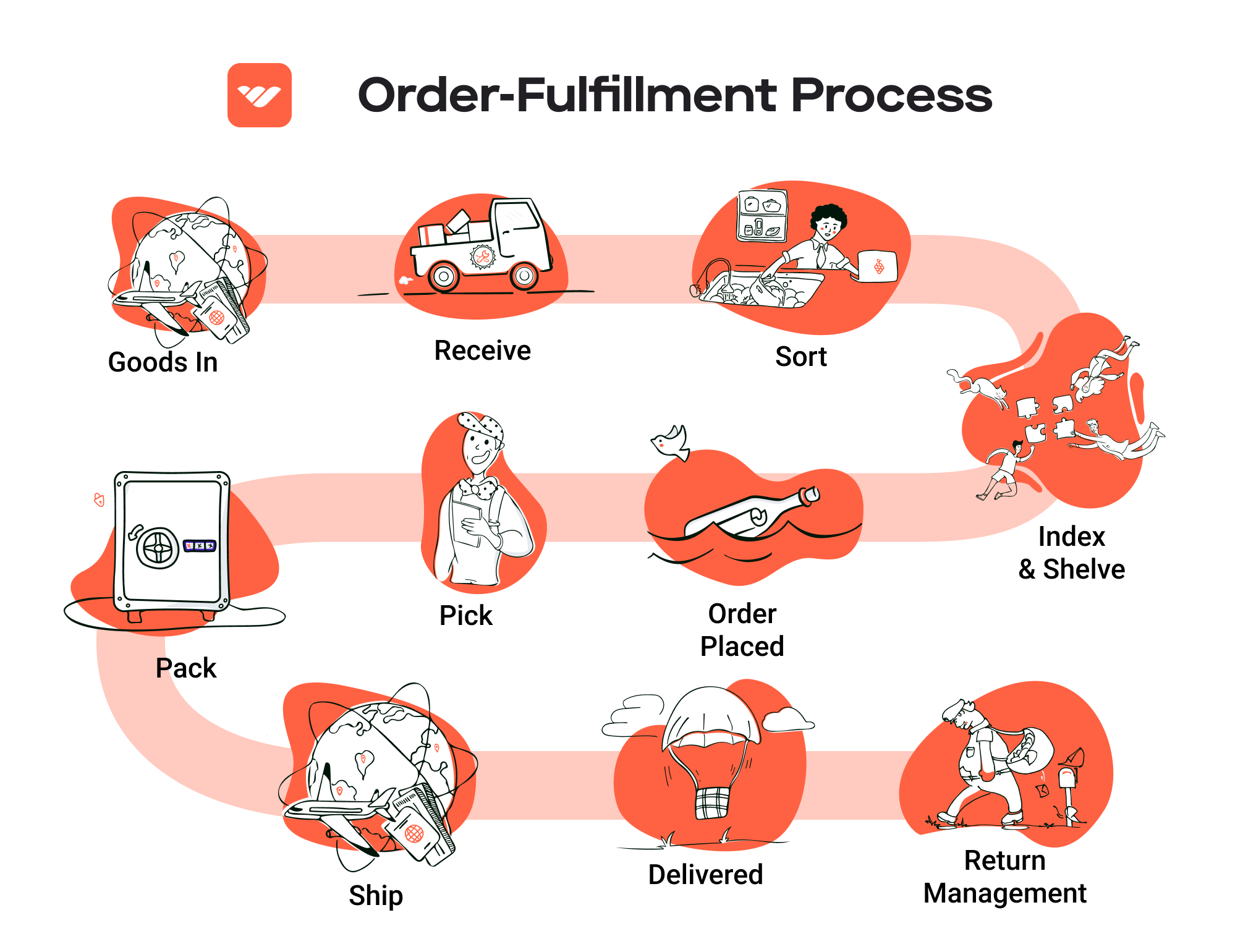
Order picking is a critical step because it directly affects order accuracy and fulfillment speed. Efficient picking strategies, such as batch picking or zone picking, can significantly enhance productivity. Moreover, the use of technology, such as barcode scanners or mobile devices, helps reduce human error and improves inventory tracking. Ultimately, effective order picking ensures that customers receive the correct products promptly, fostering satisfaction and loyalty.
4. Order Packing
After items have been picked, they move to the order packing stage. Here, products are carefully packaged for shipment. This includes selecting appropriate shipping materials (boxes, envelopes, etc.) and ensuring that items are securely packed to prevent damage during transit.
Packing is vital for several reasons: it protects the products, reduces return rates, and enhances the overall customer experience. The use of packing slips—documents that accompany the shipment detailing the contents—also plays a crucial role in confirming order accuracy. In addition, businesses can implement custom branding in packaging, which can enhance brand recognition and customer loyalty.
5. Shipping & Delivery
The final step in the fulfillment process is shipping and delivery. Once orders are packed, they are labeled and dispatched to carriers for delivery. This stage involves selecting the most efficient shipping method based on factors like cost, speed, and destination.
Shipping and delivery are pivotal for customer satisfaction, as they directly impact delivery times and costs. By leveraging relationships with carriers and utilizing shipping software, fulfillment centers can often secure discounted rates and provide tracking information to customers. This transparency helps manage customer expectations and enhances the overall shopping experience. Efficient shipping not only leads to timely deliveries but also contributes to repeat business and positive reviews.
In conclusion, mastering each of these five steps in the order fulfillment process is essential for e-commerce businesses looking to scale efficiently. By focusing on the nuances of receiving inventory, warehouse storage, order picking, order packing, and shipping & delivery, businesses can streamline operations, reduce costs, and ultimately provide a better service to their customers.
Comparing Fulfillment Models: In-House vs. 3PL vs. Dropshipping
Fulfillment Model Comparison
| Model | Who Handles Inventory | Best For (Business Stage) | Key Advantage | Key Disadvantage |
|---|---|---|---|---|
| In-House Fulfillment | Business Owner | Startups to Established | Complete control over inventory and processes | High overhead costs and operational complexity |
| Third-Party Logistics (3PL) | Third-Party Provider | Growing to Established | Scalable solutions with expertise in logistics | Less control over inventory and processes |
| Dropshipping | Supplier | Startups to New Product Launch | Low upfront costs and minimal risk | Longer shipping times and lower profit margins |
In-House Fulfillment
In-house fulfillment involves managing all aspects of storage, inventory management, order processing, and shipping within the business itself. This model is often favored by startups transitioning to established businesses that have sufficient resources and volume to justify the investment in facilities and staff. The primary advantage of in-house fulfillment is the complete control it provides over inventory and processes. Businesses can customize workflows, maintain quality standards, and adjust operations quickly based on demand fluctuations. However, this control comes with significant disadvantages, including high overhead costs related to warehousing, staffing, and technology. Additionally, operational complexity can increase as the business scales, requiring more sophisticated logistics management and potentially leading to inefficiencies if not handled properly.
Third-Party Logistics (3PL)
Third-party logistics (3PL) providers offer comprehensive warehousing and fulfillment solutions, handling everything from storage to shipping. This model is ideal for businesses that are growing and need to scale their operations without the burden of managing logistics themselves. By partnering with a 3PL, companies can leverage the provider’s expertise, technology, and economies of scale, which often results in reduced shipping costs and improved delivery times. 3PLs also typically offer advanced inventory management systems that integrate with eCommerce platforms, providing real-time updates and insights. Despite these advantages, businesses relinquish some control over their inventory and fulfillment processes. This can lead to challenges in maintaining brand consistency and quality assurance. Furthermore, the initial costs of switching to a 3PL can be significant, especially if a business has complex logistics needs.
Dropshipping
Dropshipping is a fulfillment model where the retailer does not hold inventory but instead relies on suppliers to ship products directly to customers. This model is particularly attractive for startups and businesses launching new products, as it requires minimal upfront investment and reduces financial risk. Retailers can offer a wide range of products without the costs associated with inventory storage, allowing them to test various markets and product lines with ease. However, dropshipping has notable downsides, including longer shipping times since products are shipped directly from suppliers, which can lead to customer dissatisfaction. Additionally, profit margins can be lower than in-house fulfillment or 3PL due to the costs imposed by suppliers, which may limit the retailer’s ability to scale effectively. Furthermore, reliance on suppliers for inventory and shipping can result in a lack of control over quality and fulfillment processes, which can impact brand reputation.
Conclusion
Choosing the right fulfillment model is critical for the success of any e-commerce business. Each model—whether in-house fulfillment, third-party logistics, or dropshipping—has distinct advantages and disadvantages that must be weighed against the specific needs and goals of the business. In-house fulfillment offers control but comes with higher costs and complexity. 3PLs provide scalability and expertise but may lead to a loss of control. Dropshipping minimizes risk and investment but can compromise shipping speed and profit margins. As businesses look to scale, understanding these nuances will help them make informed decisions that align with their operational strategies and customer expectations.
A Deep Dive into Amazon FBA: Pros, Cons, and Who It’s For
Understanding Fulfillment by Amazon (FBA)
Fulfillment by Amazon (FBA) is a service offered by Amazon that allows e-commerce sellers to store their products in Amazon’s fulfillment centers. Amazon takes care of storage, packaging, and shipping of these products directly to customers, alongside handling customer service and returns. This service is particularly appealing for businesses looking to scale their operations without the overhead of managing logistics themselves.
When a customer places an order for a product listed as fulfilled by Amazon, the item is picked from the fulfillment center, packed, and shipped by Amazon. Sellers benefit from Amazon’s extensive distribution network, ensuring that their products can reach customers quickly and efficiently.
How FBA Works
-
Setting Up: Sellers sign up for an Amazon Seller account and choose FBA as their fulfillment method. They can then create product listings and send their inventory to Amazon’s fulfillment centers.
-
Storage: Products are stored in Amazon’s warehouses. The seller is charged based on the amount of space their inventory occupies and the duration it remains there.
-
Order Processing: When an order is placed, Amazon’s system automatically picks, packs, and ships the product. This process is often completed within a day.
-
Customer Service: Amazon manages customer inquiries and returns, providing a seamless experience for buyers.
-
Reporting and Analytics: Sellers have access to tools that provide insights into their inventory, sales performance, and customer interactions.
Pros of Using FBA
Prime Eligibility
One of the most significant advantages of using FBA is the eligibility for Amazon Prime. Products fulfilled by Amazon are automatically eligible for Prime, which can increase visibility and sales due to the appeal of fast, free shipping. Prime members are more likely to purchase items with this perk, boosting conversion rates for sellers.
Customer Trust
Amazon has established a strong reputation for reliability and customer service. By using FBA, sellers can leverage this trust, as customers often prefer purchasing from Amazon due to their familiarity with the platform. The “Fulfilled by Amazon” badge can enhance credibility and encourage purchases.
Multi-Channel Fulfillment
FBA allows sellers to fulfill orders from multiple sales channels, not just Amazon. This means sellers can sell on their own websites or other platforms while still utilizing Amazon’s fulfillment network. This flexibility helps sellers expand their reach and streamline logistics.
Time and Resource Efficiency
By outsourcing logistics to Amazon, sellers can focus on their core business activities like marketing, product development, and customer engagement. This efficiency can lead to faster growth as resources are allocated more effectively.
Advanced Logistics
Amazon’s sophisticated logistics infrastructure allows for faster shipping and order processing. With a vast network of fulfillment centers, sellers can benefit from Amazon’s expertise in managing complex supply chains.
Cons of Using FBA
High Fees
One of the major downsides of FBA is the cost. Sellers are subject to various fees, including storage fees based on the volume of inventory and fulfillment fees for each order. These costs can accumulate, particularly for slow-moving inventory, affecting profit margins.
Strict Inventory Rules
Amazon enforces strict inventory management policies. Sellers must adhere to guidelines regarding product condition, packaging, and labeling. Failure to comply can result in additional fees or even removal from the FBA program.
Commingling Risks
When products are commingled, items from different sellers are stored together. This can lead to issues where sellers receive returns of products that are not theirs, complicating inventory management and potentially harming reputation if a customer receives the wrong item.
Limited Control
Using FBA means that sellers have less control over the fulfillment process. They must trust Amazon to handle inventory correctly and manage customer service, which can be a concern for some businesses, especially those focused on brand experience.
Inventory Management Challenges
While Amazon provides tools for inventory management, sellers must monitor their stock levels closely. Mismanagement can lead to stockouts or overstock situations, both of which can be detrimental to sales performance.
Who is FBA Best For?
FBA is best suited for small to medium-sized e-commerce businesses that want to scale quickly without the burdens of logistics. It is particularly advantageous for sellers who:
-
Sell High-Volume Products: Businesses with products that have consistent demand can benefit significantly from the efficiencies FBA provides.
-
Lack Fulfillment Infrastructure: Newer sellers without established warehousing and fulfillment processes can leverage FBA to enter the market quickly.
-
Aim for Prime Customers: Sellers targeting Amazon Prime members will find FBA invaluable due to the increased visibility and sales potential.
-
Prioritize Growth: Businesses looking to focus on scaling operations rather than logistics will find FBA a helpful solution.
In summary, while FBA offers an array of benefits, including access to Amazon’s vast customer base and robust logistics capabilities, it also comes with challenges like high fees and limited control. Sellers must weigh these factors carefully to determine if FBA aligns with their business strategy and goals.
Core Services Offered by Fulfillment Centers
Inventory Management & Warehousing
Effective inventory management and warehousing are the backbone of any successful fulfillment operation. Fulfillment centers provide dedicated storage space, which can range from small bins to large pallet positions, enabling businesses to optimize their storage needs based on their inventory volume. The benefits of this service are multifaceted.
First, fulfillment centers utilize sophisticated warehouse management systems (WMS) that track inventory levels in real-time. This means that as products are received, stored, and shipped, inventory counts are automatically updated, minimizing the risk of stockouts or overstock situations. For e-commerce businesses, this real-time visibility into inventory levels is crucial for maintaining accurate product availability on their sales channels.
Moreover, the security of stored goods is paramount. Fulfillment centers often implement 24/7 monitoring and surveillance, ensuring that products are protected against theft or damage. This level of security not only safeguards your investments but also enhances customer trust in your brand, as they can be assured their orders are being handled with care.
Additionally, warehousing solutions offered by fulfillment centers can significantly reduce operational costs. By leveraging shared storage space, businesses can avoid the high overhead costs associated with owning and maintaining their own warehouses. This flexibility allows e-commerce businesses to scale their operations up or down based on demand, thus optimizing their cash flow.
Pick and Pack Services
The pick and pack process is critical in the order fulfillment cycle, where items are selected from inventory, packed securely, and prepared for shipment. Fulfillment centers streamline this process to ensure speed and accuracy, which is vital for customer satisfaction.
When an order is placed, the fulfillment center’s system automatically generates a picking list, guiding staff on the most efficient route through the warehouse. This efficiency is key, as orders are typically fulfilled within one business day, with the option for same-day shipping in urgent cases. Such responsiveness can significantly enhance customer loyalty and retention, as consumers increasingly expect fast delivery times.
After picking, items are packed using appropriate materials that protect them during transit. Fulfillment centers stock a variety of packing supplies, including boxes, polymailers, and cushioning materials, ensuring that products arrive in pristine condition. Additionally, quality control checks are often performed before shipment, reducing the likelihood of returns due to shipping errors.
Furthermore, integration with major e-commerce platforms allows for seamless order processing. This means that businesses can manage orders from multiple sales channels in one centralized system, simplifying operations and reducing the chances of human error.
Kitting and Assembly
Kitting and assembly services are particularly advantageous for e-commerce businesses that sell bundled products or promotional items. Fulfillment centers can assemble various items into pre-defined kits, which can include anything from gift sets to point-of-purchase displays. This service not only saves time but also enhances the presentation of products.
By outsourcing kitting and assembly, businesses can focus their resources on marketing and sales rather than on the logistical complexities of preparing products for distribution. Fulfillment centers often have dedicated teams and spaces for kitting projects, allowing for scalability; whether you need a few hundred kits or thousands, they can accommodate your needs efficiently.
Additionally, the ability to shrink-wrap or package kits in a professional manner enhances the unboxing experience for customers, which can positively influence their perception of your brand. A well-presented product can lead to increased customer satisfaction and higher chances of repeat purchases.
Returns Management (Reverse Logistics)
Returns management is a critical aspect of e-commerce operations, as handling returns efficiently can significantly affect customer satisfaction and overall profitability. Fulfillment centers offer robust returns management services that simplify the process of reverse logistics.
When a customer initiates a return, fulfillment centers can process the return quickly, updating inventory levels in real-time and ensuring that the returned items are either restocked or properly disposed of. This prompt handling minimizes the impact of returns on inventory availability and helps maintain accurate stock levels.
Moreover, a well-structured returns process can enhance customer trust and loyalty. By offering easy returns, businesses can reduce the perceived risk of purchasing online, encouraging customers to make purchases with the confidence that they can return items if needed. This is particularly important in industries with high return rates, such as fashion and electronics.
Fulfillment centers often provide analytics on return reasons, which can offer valuable insights into product performance and customer preferences. This data can inform product development and marketing strategies, helping businesses reduce return rates over time.
In summary, the core services offered by fulfillment centers—inventory management and warehousing, pick and pack services, kitting and assembly, and returns management—are essential for e-commerce businesses aiming to scale efficiently. By leveraging these services, businesses can focus on growth while ensuring that their logistics operations are handled with expertise and precision.
How to Choose a Fulfillment Partner: A 6-Point Checklist
Location & Warehouse Network
Why It’s Important:
The geographical location of a fulfillment partner’s warehouses can significantly impact shipping times and costs. A partner with multiple strategically located warehouses can help ensure faster delivery to your customer base, which is critical for maintaining customer satisfaction and competitive advantage.
Questions to Ask:
– Where are your fulfillment centers located, and how does this affect shipping times to my target markets?
– Do you have the capacity to expand into new regions if my business grows?
– How do you manage logistics and transportation between your warehouses and my customers?
Technology & Integrations
Why It’s Important:
In today’s e-commerce landscape, seamless technology integration is crucial for efficient operations. A partner that offers advanced warehouse management systems (WMS) and integrates easily with popular e-commerce platforms can streamline your order processing, inventory management, and shipping notifications.
Questions to Ask:
– What warehouse management software do you use, and how does it integrate with major e-commerce platforms like Shopify, Amazon, or Magento?
– Can you provide real-time inventory updates and tracking for my customers?
– How do you handle data security and privacy in your technology systems?
Specializations (e.g., Cold Storage, Oversized Items)
Why It’s Important:
Depending on your product line, specific capabilities may be essential. For example, if you sell perishable goods, having a partner with cold storage capabilities is non-negotiable. Similarly, if you deal in oversized or fragile items, special handling requirements are critical.
Questions to Ask:
– What special capabilities do you have for handling my product types, such as cold storage, kitting, or custom packaging?
– Have you worked with businesses in my industry, and can you provide examples of how you managed specific challenges?
– What processes do you have in place for quality control and damage prevention during storage and shipping?
Scalability & Capacity
Why It’s Important:
As your business grows, your fulfillment needs will likely change. A partner that can scale with you—whether it’s handling increased order volumes during peak seasons or adapting to new product lines—ensures that you won’t have to switch partners frequently.
Questions to Ask:
– What is your current capacity for handling orders, and how have you managed scaling in the past?
– How do you accommodate seasonal fluctuations in order volume?
– Can you provide a clear plan for scaling operations if my business doubles in size?
Pricing and Contracts
Why It’s Important:
Understanding the pricing structure and contractual obligations of a fulfillment partner is crucial for budgeting and financial planning. Transparency in pricing helps you avoid hidden fees and ensures that you can maintain profitability as you scale.
Questions to Ask:
– What is your pricing model for storage, pick and pack, and shipping services?
– Are there any hidden fees or minimum order requirements I should be aware of?
– What are the terms of the contract? Is there flexibility in the length of commitment, and what happens if I need to exit the agreement?
Customer Support & Reviews
Why It’s Important:
Exceptional customer support can make a significant difference in how effectively your orders are fulfilled. A responsive partner can help resolve issues quickly, minimizing disruption to your business. Additionally, reviews and testimonials provide insights into the partner’s reliability and service quality.
Questions to Ask:
– What does your customer support structure look like? Will I have a dedicated account manager?
– Can you provide references or case studies from similar businesses that you’ve worked with?
– How do you handle order discrepancies or customer complaints? What is your process for resolution?
By utilizing this checklist, e-commerce business owners, operations managers, and entrepreneurs can make informed decisions when selecting a fulfillment partner. Each item addresses critical areas that impact the efficiency, effectiveness, and overall success of your logistics operations. By asking the right questions and understanding the importance of each factor, you can forge a partnership that not only meets your current needs but also supports your growth objectives.
Understanding Fulfillment Pricing: A Breakdown of Common Fees
Initial Setup Fees
Initial setup fees are one-time charges incurred when establishing a relationship with a fulfillment provider. These fees cover the costs associated with integrating your business systems with the fulfillment center’s operations, including software setup, inventory mapping, and initial onboarding support.
Typically, initial setup fees can range from a few hundred to several thousand dollars, depending on the complexity of your operations and the level of customization required. Some providers may waive these fees if you commit to a long-term contract or meet specific volume thresholds. To get an accurate estimate, it’s advisable to discuss your specific needs and the services you plan to utilize with the fulfillment provider.
Receiving Fees
Receiving fees are charged each time your products are delivered to the fulfillment center. This fee covers the labor and equipment costs involved in unloading, inspecting, and entering the inventory into the warehouse management system (WMS).
These fees are often calculated on a per-pallet or per-box basis, and can vary significantly based on the type of product, the complexity of the receiving process, and the provider’s location. For example, specialized items requiring extra handling or inspection may incur higher fees. To ensure you’re prepared for these costs, it’s essential to provide your fulfillment partner with detailed product specifications and shipment volumes.
Storage Fees (per pallet/bin)
Storage fees are charged for the space your inventory occupies within the fulfillment center. These fees can be calculated on a per-pallet, per-bin, or cubic foot basis, depending on the storage method used by the provider.
Typically, storage fees are billed monthly and can vary widely based on factors such as location, the type of storage (rack vs. floor), and the length of time your products are stored. For instance, high-demand items may incur lower fees due to quicker turnover, while slow-moving inventory may lead to higher storage costs over time. To manage these fees effectively, consider forecasting your inventory needs and discussing potential storage options with your provider.
Pick & Pack Fees (per item/order)
Pick and pack fees are charged for the labor involved in selecting items from inventory and preparing them for shipment. This fee is typically calculated on a per-item or per-order basis, and it can vary based on the complexity of the picking process and the volume of orders.
For example, a straightforward order with a single item will generally incur a lower fee than a complex order requiring multiple items and custom packaging. Additionally, if your fulfillment provider offers value-added services such as kitting or special packaging, these may incur additional charges. To optimize these costs, consider consolidating orders and minimizing the number of different SKUs in a single shipment.
Shipping Fees
Shipping fees cover the costs associated with transporting your products to customers. These fees can vary based on several factors, including the shipping method (ground, air, international), package weight and dimensions, and the shipping destination.
Fulfillment providers often have established relationships with major carriers, allowing them to negotiate discounted shipping rates that can be passed on to you. Shipping fees may also include additional charges for handling, tracking, and insurance. To gain clarity on shipping costs, it’s advisable to work with your fulfillment partner to understand their carrier relationships and how these can impact your overall shipping expenses.
Conclusion: Tips for Getting an Accurate Quote
To receive a comprehensive and accurate fulfillment quote, consider the following tips:
-
Be Transparent: Provide detailed information about your product types, expected order volumes, and specific fulfillment needs. This will help the provider tailor their quote to your operations.
-
Understand Your Needs: Clearly define the services you require, including storage, pick and pack, and shipping. This will help you avoid surprise fees later on.
-
Ask About Discounts: Inquire about volume discounts or waived fees for long-term commitments, as many providers are willing to negotiate based on expected business levels.
-
Compare Multiple Providers: Don’t settle for the first quote. Compare offers from multiple fulfillment centers to ensure you’re getting the best deal for your specific needs.
-
Review Contract Terms: Before signing, carefully review the terms related to fees and services to ensure there are no hidden charges.
By following these guidelines, you can gain a better understanding of fulfillment pricing and make informed decisions that contribute to your business’s scalability and profitability.
Frequently Asked Questions (FAQs) about Fulfillment
1. What is a fulfillment center?
A fulfillment center is a specialized warehouse that handles the storage, processing, and shipping of products for e-commerce businesses. Unlike traditional warehouses, fulfillment centers focus on efficiently managing inventory and order fulfillment, ensuring timely delivery to customers. This includes activities such as picking, packing, and shipping orders directly to consumers or retailers.
2. What’s the difference between a warehouse and a fulfillment center?
While both warehouses and fulfillment centers serve the purpose of storing goods, the key difference lies in their operations. Warehouses primarily focus on long-term storage of inventory, whereas fulfillment centers are designed to handle the logistics of processing and shipping orders quickly. Fulfillment centers are equipped with technology and systems that enable them to efficiently manage order fulfillment, often integrating with e-commerce platforms for real-time inventory management.
3. What is a 3PL?
A Third-Party Logistics (3PL) provider is a company that offers outsourced logistics services, which can include warehousing, fulfillment, transportation, and distribution. 3PLs help businesses streamline their supply chain operations, allowing them to focus on core competencies while leveraging the expertise and infrastructure of the 3PL for efficient logistics management.
4. How much do fulfillment services cost?
The cost of fulfillment services can vary significantly based on several factors, including order volume, types of products, storage needs, and the specific services utilized (such as kitting or special packaging). Many fulfillment centers, including Elite Fulfillment Solutions, offer transparent pricing with no setup fees or long-term contracts, providing custom quotes based on your specific requirements.
5. How does Elite Fulfillment Solutions ensure inventory accuracy?
Elite Fulfillment Solutions employs a robust warehouse management system that integrates with e-commerce platforms to provide real-time inventory updates. This system tracks inventory levels, processes orders, and automatically updates stock counts, ensuring accuracy and minimizing the risk of stockouts or overselling.
6. Can I integrate my existing e-commerce platform with Elite Fulfillment Solutions?
Yes, Elite Fulfillment Solutions offers seamless integration with major e-commerce platforms such as Amazon, Shopify, Magento, and more. This integration allows for automatic order importation, inventory updates, and real-time tracking, streamlining your fulfillment process.
7. What shipping options are available through Elite Fulfillment Solutions?
Elite Fulfillment Solutions partners with major carriers like USPS, FedEx, UPS, and DHL, offering a range of shipping options to meet your needs. With the volume of shipments they handle, they can provide competitive shipping rates and help you choose the most cost-effective option for your orders.
8. How quickly can my orders be fulfilled?
Elite Fulfillment Solutions typically processes and fulfills orders within one business day of receipt. For urgent requests, same-day shipping options are available. This efficiency helps ensure that your customers receive their orders promptly, enhancing their overall experience.
9. What types of products can be stored and fulfilled?
Elite Fulfillment Solutions can handle a wide variety of products, including small items, bulk goods, and custom kits. Their facilities are equipped to manage different storage methods, including bin, carton, and pallet storage, making them suitable for diverse product types and sizes.
10. What support does Elite Fulfillment Solutions provide for customer service?
Elite Fulfillment Solutions is dedicated to exceptional client service, offering a responsive customer support team to assist with order processing, client inquiries, and logistical needs. Their focus on communication ensures that any issues are addressed promptly, allowing your business to maintain high customer satisfaction levels.
Conclusion: Is Outsourcing Fulfillment the Right Move for Your Business?
The Case for Outsourcing Fulfillment
Outsourcing your fulfillment can be a game-changer for e-commerce businesses looking to scale efficiently. One of the primary benefits is the significant time savings. By entrusting storage, inventory management, order processing, and shipping to an experienced partner, you free up valuable hours that can be redirected toward core business activities like marketing, product development, and customer engagement. This shift allows you to focus on what you do best while leaving the logistics to the experts.
Scalability is another critical advantage. As your sales volume fluctuates, a reliable fulfillment service can adapt to your needs without the burden of managing additional infrastructure or workforce. Whether you’re experiencing seasonal spikes or rapid growth, a fulfillment partner can provide the necessary resources to ensure orders are processed efficiently and accurately.
Moreover, leveraging a fulfillment service means gaining access to specialized expertise and technology that can enhance your supply chain operations. From sophisticated warehouse management systems to negotiated shipping rates, these partners bring a level of professionalism and efficiency that is often hard to replicate in-house.
However, choosing the right fulfillment partner is paramount to your success. A misaligned partnership can lead to costly mistakes and dissatisfied customers, undermining your growth efforts. Take the time to evaluate potential partners based on their services, technology integrations, and customer service capabilities.
To determine if outsourcing fulfillment is the right move for your business, conduct a thorough audit of your current shipping processes. Assess your pain points, costs, and time commitments. This reflection will help you make an informed decision on whether a fulfillment partner can support your growth objectives effectively. Embrace the opportunity to enhance your operations and scale your business with the right fulfillment strategy.
Important Disclaimer
⚠️ Important Disclaimer
The information in this guide is for educational purposes. Fulfillment services, pricing, and platform features change frequently. Always conduct your own due diligence and consult with providers directly before making business decisions.


